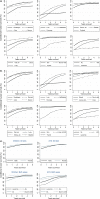Long-term survival and conditional survival of cancer patients in Japan using population-based cancer registry data
- PMID: 25183551
- PMCID: PMC4462379
- DOI: 10.1111/cas.12525
Long-term survival and conditional survival of cancer patients in Japan using population-based cancer registry data
Abstract
Although we usually report 5-year cancer survival using population-based cancer registry data, nowadays many cancer patients survive longer and need to be followed-up for more than 5 years. Long-term cancer survival figures are scarce in Japan. Here we report 10-year cancer survival and conditional survival using an established statistical approach. We received data on 1,387,489 cancer cases from six prefectural population-based cancer registries in Japan, diagnosed between 1993 and 2009 and followed-up for at least 5 years. We estimated the 10-year relative survival of patients who were followed-up between 2002 and 2006 using period analysis. Using this 10-year survival, we also calculated the conditional 5-year survival for cancer survivors who lived for some years after diagnosis. We reported 10-year survival and conditional survival of 23 types of cancer for 15-99-year-old patients and four types of cancer for children (0-14 years old) and adolescent and young adults (15-29 years old) patients by sex. Variation in 10-year cancer survival by site was wide, from 5% for pancreatic cancer to 95% for female thyroid cancer. Approximately 70-80% of children and adolescent and young adult cancer patients survived for more than 10 years. Conditional 5-year survival for most cancer sites increased according to years, whereas those for liver cancer and multiple myeloma did not increase. We reported 10-year cancer survival and conditional survival using population-based cancer registries in Japan. It is important for patients and clinicians to report these relevant figures using population-based data.
Keywords: Cancer; cancer registry; conditional survival; period analysis; survival.
© 2014 The Authors. Cancer Science published by Wiley Publishing Asia Pty Ltd on behalf of Japanese Cancer Association.
Figures


References
-
- Allemani C, Minicozzi P, Berrino F, et al. Predictions of survival up to 10 years after diagnosis for European women with breast cancer in 2000–2002. Int J Cancer. 2013;132:2404–12. - PubMed
-
- Talback M, Dickman PW. Predicting the survival of cancer patients recently diagnosed in Sweden and an evaluation of predictions published in 2004. Acta Oncol. 2012;51:17–27. - PubMed
-
- Lee JY, Jung KW, Park S, et al. Long-term survival of cancer patients in Korea, 1993–2007: National Cancer Registry Study. Asian Pac J Cancer Prev. 2010;11:1459–64. - PubMed
-
- Arndt V, Kaatsch P, Steliarova-Foucher E, Peris-Bonet R, Brenner H. Up-to-date monitoring of childhood cancer long-term survival in Europe: central nervous system tumours. Ann Oncol. 2007;18:1734–42. - PubMed
-
- Zuccolo L, Dama E, Maule MM, Pastore G, Merletti F, Magnani C. Updating long-term childhood cancer survival trend with period and mixed analysis: good news from population-based estimates in Italy. Eur J Cancer. 2006;42:1135–42. - PubMed
Publication types
MeSH terms
LinkOut - more resources
Full Text Sources
Other Literature Sources

